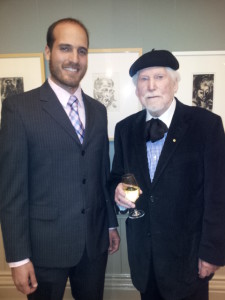 Last week we were blessed to have attended an art gallery opening at the State Library of South Australia. Franz Kempf graciously donated a number of works which the library is selling to raise money.
Last week we were blessed to have attended an art gallery opening at the State Library of South Australia. Franz Kempf graciously donated a number of works which the library is selling to raise money.
We are honoured to have such an acclaimed artist in our community. Franz asked me if I would speak at the opening, which I did, and I thought some of you may appreciate reading the speech.
There is one thing I did not mention in the speech though, and it is the number one thing that comes to mind whenever I think about Franz. Virtually, every Sabbath morning Franzis at the Synagogue, and more often than not, he is the first one there. It’s not always easy for him to come. He is obviously very busy finding time to create art, selling art, and setting up exhibitions, though he still makes the effort. Please G-d we hope to count him in the minyan for many more years to come.
Now for the speech…I’ve adapted it slightly….
Ladies and gentleman, honoured guests, Franz – I am grateful to be here today to celebrate with you this wonderful collection of art. After Franz asked me to share a few words, I sat down at the computer and I Googled, ‘What to say at an art gallery opening. The first thing that came up, was a blog article titled, ”7 things never to say at an art gallery’ which included:
How much just for the frame?
My nephew does similar work. He’s two.
Do you have this in medium?
I also realised that it has been some time since I’ve last been to an art opening and thought I should brush up on proper etiquette. So I Googled, ‘Art gallery opening etiquette,’ and the first entry was, ‘Behavioural Blunders for Everyone.’ It had an in-depth list…
Don’t bring your pets
Don’t touch the art
Don’t get drunk or better yet, arrive drunk!
One of the things I like about Franz is he always has a joke. As a Rabbi, I’m pretty good at Jewish jokes, so I thought I should have a few Art jokes if I am going to an art opening. So I sat down at the computer again, and Googled, ‘Art Jokes’
Art Teacher: “The picture of the horse is good, but where is the wagon?”
Student: “The horse will draw it!” (I didn’t find this one funny either!)
Question: How many visitors to an Art Gallery does it take to change a light bulb?
Answer: Two. One to do it and one to say “Huh! My four-year old could’ve done that!”
When it comes to appreciating art, we usually first have a relationship with the art and then if we are fortunate we get to meet the artist if they are around. However, for the most part we try to understand the artist by the work they’ve created. It was six months after I met Franz until I knew he was an artist, and yet a further six months until I saw any of his work. I got to know Franz first as a person; when I see Franz on a Saturdaymorning, impeccably dressed, holding hands with his wife Tamar, always with a smile, followed by a good word and something interesting to share, this is the most beautiful art.
What an artist can create is only a glimpse and a hint of who the artist is. But the more one knows of the artist the more we can appreciate and understand what they have created. Otherwise we are left speculating.
There are two aspects when it comes to art, 1) is what the artist is trying to tell us, 2) is what we think the artist is trying to tell us.…
A little old lady was among a group at an art exhibition in a newly opened gallery.
Suddenly one contemporary painting caught her eye. What on earth, she inquired of the artist standing nearby, is that? He smiled condescendingly. That, my dear lady, is supposedto be a mother and her child. Well, then snapped the little old lady, Why isn’t it?
Each of us translates art differently; the way we see it depends on our way of life. We see things not by the way they are, rather by the way we are. The beauty in art is always in the eyes of the beholder. Art appreciation is unique for each individual yet there is still that universal force that brings us all together.
My Grandmother, may she rest in peace, loved Claude Monet work. Every week I used to send her cards while she was alive and more often than not I would find cards depicting Monet work. I understand why Grandma liked Monet. Anyone can look at a Monet and feel pleasant inside. Most of Monet’s works are bright and cheerful scenes that have a definite character and structure. The names subscribed to the paintings clearly illustrate what’s going on in them, and we can comfortably let ourself get lost in them.
Franz’s work is very different. Aside from perhaps some of his landscapes, his art is not designed to give us warm fuzzy feeling inside. Franz who takes the stance as a humanist, and spiritualist, wants the viewer to think, to question and as is the case with much spiritual based art, for the reader to interpret it in whichever way they choose.
There are a number of themes that run throughout Franz work, most of it is rarely literal or descriptive. The images tend to be more of a metaphor, where for the large part it is up to the viewer to decide what they want. Unlike the joke with the painting of the mother and her child, with Franz’s work you can choose to see only a mother, only a daughter, or neither of them.
The art we see here at this exhibition, is a collection of sketches. As Franz has expressed to me, sometimes the sketch is an end in itself, whilst at times it is like taking a note to capture an idea. Sometimes those ideas turn into paintings, as some of these sketches have. It is also possible that more of these sketches you are looking at will one day transform into paintings, and take on a new life of their own.
One of the most famous artists of all time Is Leonardo Da Vinci. Leonardo painted the ‘Mona Lisa’ which today is arguably the most viewed painting around. Leonardo, later in his life, is said to have regretted “never having completed a single work.” He also said, “art is never finished, only abandoned.”
A work of art is constantly evolving, be it theatre, music and in our case drawings. As an individual, and or, as a society evolves their attitudes, feelings and beliefs change. And this is reflected back into the art of the time.
I’d like to conclude with a quote from Pirkei Avot, Ethics of our Fathers which is a collection of wisdom from Jewish sages two thousand years ago.
“He [Rabbi Tarfon] used to say: It is not upon you to complete the task, but you are not free to idle from it.
A person’s job here in the world is never complete even when they take their last breath. So long as we are alive we must continue to contribute in making the world a better place, each person in his or her own unique way by expressing the gifts G-d has bestowed upon them.
Franz: We wish you and bless you may you go from strength to strength and continue to inspire, interest, and intrigue us for many more years to come.
Thank you.
Read More







